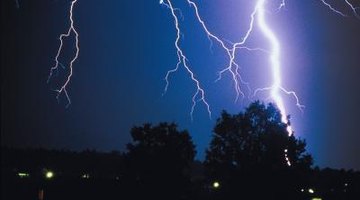How to Set a Seth Thomas Barometer
Seth Thomas has been making clocks and barometers for almost 200 years. All original barometers were aneroid types, most with a circular face. Whichever Seth Thomas barometer you have, you will use the adjustment key or a screwdriver to adjust the set screw at the back of the barometer to set it to reflect local conditions and altitude. All barometers are corrected, or calibrated, to read what they would be at sea level, at which the normal reading for a clear, calm day would be 29.92. The reason for this is so that readings across the world will be consistent at normal, calm weather. Thus, if you are at an altitude of 5,000 feet, normal pressure would be somewhere around 23.90, but scientists and meteorologists calibrate the local dial so it registers a normal sea level reading.

Step 1
Locate the slot or screw at the back of the Seth Thomas barometer where the circular dial hand is adjusted. Most Seth Thomas barometers have two hands at the front. One, the floating hand, moves automatically based on changes in air pressure. The adjustable dial is used to correct your local barometer to what the readings would be at sea level, by moving it to what the reading would be on a calm clear day. The dial can be adjusted by either a key that came with the barometer and fits into the back or a screwdriver that can adjust a set screw.
Step 2
Call a local weather bureau, airport or television station to get what the default normal pressure is for your area. If none is easily available, wait for a day when the weather is calm and clear. Take the reading from the floating hand. Confirm that reading by doing it again on another day that is calm and clear. The spot where the floating hand regularly sets on a clear, calm day is where the dial should be set to 29.92 at the fixed hand.
Step 3
Use the key or screwdriver to adjust the dial so that the fixed hand reads at 29.92. This is the default setting for your local area. Your barometer readings will be based on how far above or below this setting the floating hand is on a given day.
Step 4
Read the barometer by checking how far above or below the fixed hand the floating hand is. A single reading is not enough. You should check a reading and then check again 15 to 30 minutes later to see whether the floating needle is rising or falling. A needle that is rising above 29.80 indicates that weather is clearing and little precipitation is likely. When it begins to fall below 29.80, it indicates precipitation is likely.
References
Resources
Tips
- A barometer reads the pressure of the piled air in the atmosphere. Barometers can also be used to measure altitude. For every 25 feet you climb, air pressure drops 1 millibar, or about .03 on your barometer. This is why the barometer must be adjusted to normal local conditions. The normal air pressure for a calm, clear day is much different at sea level than it is at 1,000 feet above sea level.
Warnings
- Do not try to adjust the dial on your barometer based on altitude alone. While altitude is the single most important factor, normal temperature in your area and the longitude and latitude also affect the proper reading of the barometer. The actual default sea level reading uses a specific latitude and longitude. Always use information from reliable local sources or the test readings you make, yourself, to set the dial properly.
Writer Bio
Joe McElroy has been writing on politics and culture since 1983. His articles have appeared in a diverse array of publications, including the "Chicago Daily Observer" and "Immaculata" magazine. McElroy works occasionally as a strategic consultant to federal candidates. He majored in American history at Northwestern University.
Photo Credits
- Jupiterimages/Photos.com/Getty Images
More Articles



